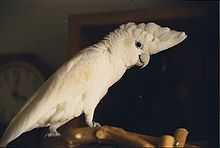Solomons cockatoo
- Cacatua goffini redirects here. This synonym for Cacatua ducorpsii was used previously for the Tanimbar corella or Goffin's cockatoo
| Solomons cockatoo | |
|---|---|
 | |
| Conservation status | |
| Scientific classification | |
| Kingdom: | Animalia |
| Phylum: | Chordata |
| Class: | Aves |
| Order: | Psittaciformes |
| Superfamily: | Cacatuoidea |
| Family: | Cacatuidae |
| Subfamily: | Cacatuinae |
| Tribe: | Cacatuini |
| Genus: | Cacatua |
| Subgenus: | Licmetis |
| Species: | C. ducorpsii |
| Binomial name | |
| Cacatua ducorpsii (Pucheran, 1853) | |
| Synonyms | |
|
Cacatua tanimberensis Roselaar & Prins,
2000 | |
The Solomons cockatoo (Cacatua ducorpsii), also known as the Ducorps' cockatoo, Solomons corella or broad-crested corella, is a species of cockatoo endemic to the Solomon Islands. This small white cockatoo is larger than the Tanimbar corella yet smaller than the umbrella cockatoo. The species is common across most of the Solomons, absent only from Makira in the south. It inhabits lowland rainforests, secondary forests, cleared areas and gardens.
Description
The Solomons cockatoo is about 30 cm (12 in) long. They are predominantly white. They have a blue eye ring and a recumbent crest which resembles a sail in its raised state. As other members of the subgenus Licmetis, it has a pale bill.
Breeding
The Solomons cockatoo nests in tree cavities. The eggs are white and there are usually two in a clutch. The eggs are incubated for about 25 days and the chicks leave the nest about 62 days after hatching.[3]
References
- ↑ BirdLife International (2012). "Cacatua ducorpsii". IUCN Red List of Threatened Species. Version 2013.2. International Union for Conservation of Nature. Retrieved 26 November 2013.
- ↑ Roselaar, C.S.; J.P. Michels. "Nomenclatural chaos untangled, resulting in the naming of the formally undescribed Cacatua species from the Tanimbar Islands, Indonesia (Psittaciformes: Cacatuidae)". Systematic notes on Asian birds 48.
- ↑ Alderton, David (2003). The Ultimate Encyclopedia of Caged and Aviary Birds. London, England: Hermes House. p. 205. ISBN 1-84309-164-X.
External links
- World Parrot Trust Parrot Encyclopedia - Species Profiles
| ||||||||||||||||||||||||||||||||||||||||||||||||||||||||||||||
